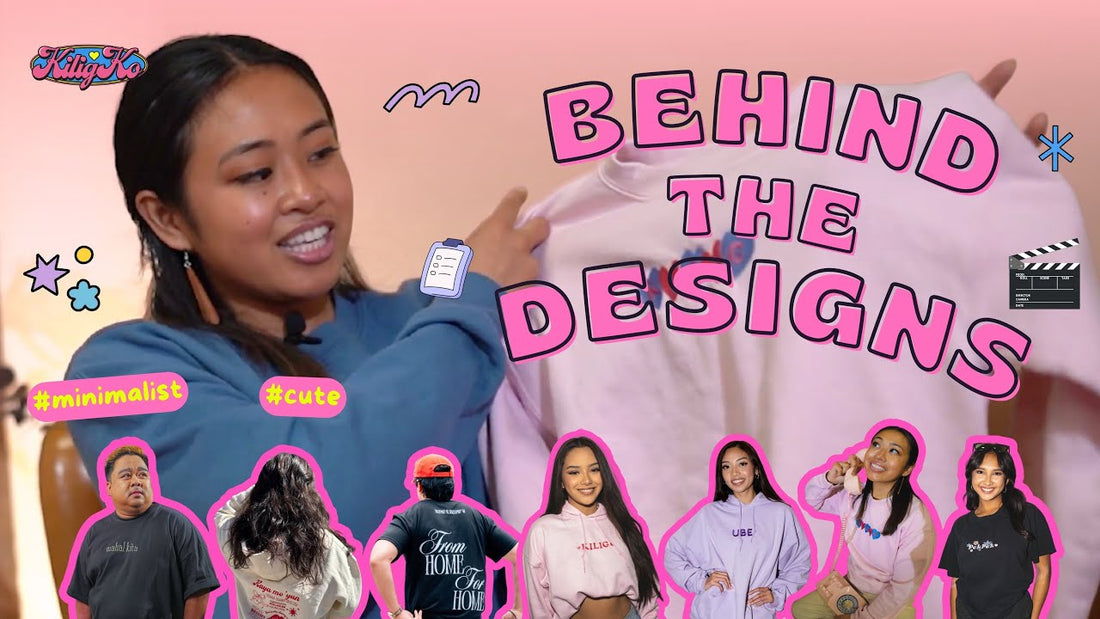Click image to watch full video
-
When people ask me what kind of pieces Kilig Ko makes, I always say: it’s clothes that carry my history, my culture, and who I am. Here’s the kind of behind story you can’t strip down to trends.
Why Minimalism Works
I’ve always gravitated toward simple, playful visuals- something cute, clean, and easy to read. But there’s always more beneath the surface. Every design holds a hidden meaning, a small lesson about Filipino identity, history, or community. Think of them as tiny cultural capsules.
Four Emojis, A Whole Story - One of my current favorites came from a simple experiment with color. I didn’t even know I liked it until I wore it. The design? Four minimalist emojis: the Philippine flag, a banana leaf, a barong, and a bottle of banana ketchup. It’s simple, sure, but also instantly recognizable to anyone who knows. It doesn’t capture everything about the culture, but it’s a start, and I’m already dreaming about future collections centered on food, cities, and the everyday textures of the Philippines.
Ube: The Unexpected Best Seller - Funny enough, one of my most popular designs wasn’t planned at all. I embroidered the word UBE on a purple shirt just for fun, before Kilig Ko even existed. People immediately started asking, “Where can I get one?” That spontaneous project became a brand-defining piece. And it opened the door for me to teach something small, but important: ube is a Filipino staple, not the same thing as taro, despite what you might see in trendy boba shops.
Love in Translation: Mahal Kita - When I released the Mahal Kita design, it felt personal. Growing up, I rarely heard “I love you” from my Filipino parents. Their love was shown through food, care, and sacrifice. So I thought: if they can’t say it, at least we can wear it. That shirt became both an affirmation and a reminder — to love others, yes, but also to love yourself. For me, it doubled as therapy stitched in cotton.
Mapping the Diaspora: Little Manila - Another early design, Little Manila, started as a way to highlight Filipino enclaves across the U.S. Stockton, New York, Los Angeles- places where communities thrived despite invisibility in mainstream culture. I hid flag symbolism in the design (triangle, sun, color-blocked sections) without screaming patriotism. It became a puzzle for those who looked closer, a nod to pride in the diaspora.
Ingat Po: The Weight of Goodbye - One of my heaviest but most meaningful designs is Ingat Po. Many people think “ingat” is just a casual way to say goodbye. But during the Marcos dictatorship, it carried literal life-or-death weight. Families didn’t know if they’d see each other again. To me, preserving that context through clothing felt urgent. It’s fashion, yes, but it’s also history you can carry on your back.
Kilig: The Heart of It All - And of course, there’s kilig- the feeling you get when you see your crush, those butterflies in your stomach. It’s famously untranslatable, now officially recognized in English. That word became the brand’s anchor, because Kilig Koo isn’t really about selling these designs, but about translating the feelings, stories, and symbols of being Filipino into something we can share.
Behind the Thread: My Creative Process
Most of my ideas start impulsively- a word, a color, a symbol I can’t get out of my head. I embroider it, wear it, see how people respond. If customers connect, it stays. If not, it becomes a personal archive. The research is constant: digging into history, learning new contexts, talking with my community. Every piece is a form of storytelling
The Bigger Mission
Fashion is the medium, but the mission is cultural education. I want my designs to correct misconceptions, connect Filipino-Americans to their heritage, and spark curiosity from non-Filipinos. When someone asks, “What does that mean?” I know the shirt did its job.
Looking Ahead
I’m dreaming of full collections around Filipino food, maps of cities, and the deeper layers of our shared history. I want my Instagram not just to show clothes, but to each the stories behind them. Because this is about more than just what we wear but about who we are.
What Other Creators Can Learn
Start with something personal. The best ideas often begin as accidents.
Do your homework. Respect and accuracy matter when you’re carrying culture.
Use your product as a teacher. Every item can spark learning.
Listen to your audience. They’ll tell you what resonates.
Balance depth with accessibility. You want to invite people in, not shut them out.
Kilig Ko is still growing, but at its core, it’s about this: turning clothing into connection, and making culture something you can wear with pride. Right now, you can find some designs online, catch others at pop-up events, or even grab a piece by sliding into the DMs. However they get out into the world, each shirt carries a story, and I’m grateful to everyone who’s chosen to wear it.
<3 Sarah
Uploaded on: Kilig Ko | Youtube
Date: August 20, 2025, 6 PM PDT
Follow Sarah on IG


